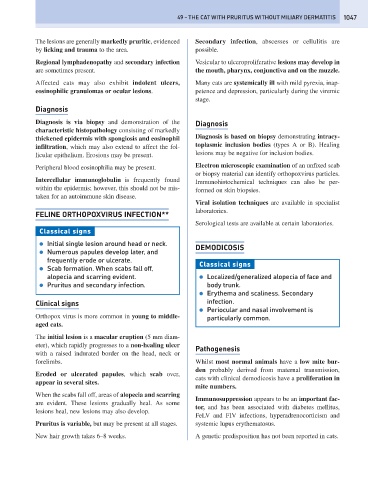Page 1055 - Problem-Based Feline Medicine
P. 1055
49 – THE CAT WITH PRURITUS WITHOUT MILIARY DERMATITIS 1047
The lesions are generally markedly pruritic, evidenced Secondary infection, abscesses or cellulitis are
by licking and trauma to the area. possible.
Regional lymphadenopathy and secondary infection Vesicular to ulceroproliferative lesions may develop in
are sometimes present. the mouth, pharynx, conjunctiva and on the muzzle.
Affected cats may also exhibit indolent ulcers, Many cats are systemically ill with mild pyrexia, inap-
eosinophilic granulomas or ocular lesions. petence and depression, particularly during the viremic
stage.
Diagnosis
Diagnosis is via biopsy and demonstration of the Diagnosis
characteristic histopathology consisting of markedly
thickened epidermis with spongiosis and eosinophil Diagnosis is based on biopsy demonstrating intracy-
infiltration, which may also extend to affect the fol- toplasmic inclusion bodies (types A or B). Healing
licular epithelium. Erosions may be present. lesions may be negative for inclusion bodies.
Peripheral blood eosinophilia may be present. Electron microscopic examination of an unfixed scab
or biopsy material can identify orthopoxvirus particles.
Intercellular immunoglobulin is frequently found Immunohistochemical techniques can also be per-
within the epidermis; however, this should not be mis- formed on skin biopsies.
taken for an autoimmune skin disease.
Viral isolation techniques are available in specialist
laboratories.
FELINE ORTHOPOXVIRUS INFECTION**
Serological tests are available at certain laboratories.
Classical signs
● Initial single lesion around head or neck. DEMODICOSIS
● Numerous papules develop later, and
frequently erode or ulcerate.
Classical signs
● Scab formation. When scabs fall off,
alopecia and scarring evident. ● Localized/generalized alopecia of face and
● Pruritus and secondary infection. body trunk.
● Erythema and scaliness. Secondary
Clinical signs infection.
● Periocular and nasal involvement is
Orthopox virus is more common in young to middle- particularly common.
aged cats.
The initial lesion is a macular eruption (5 mm diam-
eter), which rapidly progresses to a non-healing ulcer
Pathogenesis
with a raised indurated border on the head, neck or
forelimbs. Whilst most normal animals have a low mite bur-
den probably derived from maternal transmission,
Eroded or ulcerated papules, which scab over,
cats with clinical demodicosis have a proliferation in
appear in several sites.
mite numbers.
When the scabs fall off, areas of alopecia and scarring
Immunosuppression appears to be an important fac-
are evident. These lesions gradually heal. As some
tor, and has been associated with diabetes mellitus,
lesions heal, new lesions may also develop.
FeLV and FIV infections, hyperadrenocorticism and
Pruritus is variable, but may be present at all stages. systemic lupus erythematosus.
New hair growth takes 6–8 weeks. A genetic predisposition has not been reported in cats.

